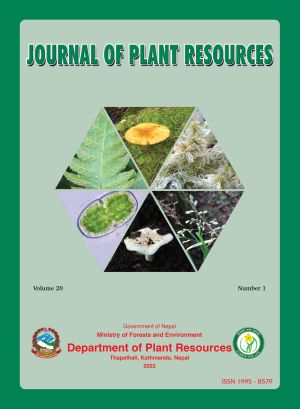Anatomical Study of Shorea robusta Gaertn.
DOI:
https://doi.org/10.3126/bdpr.v20i01.56599Keywords:
Cyclocytic stomata, Diffuse-porous wood, Glandular trichomes, Hypostomatic leaves, SalAbstract
Shorea robusta, commonly known as Sal, is one of the multipurpose timber trees in Nepal. This study aims to carry out detailed anatomical investigation of the wood and leaf anatomical traits of Sal. The wood and leaf samples of Sal were collected from Rupandehi district, Nepal. Wood of Sal was found to be diffuse-porous and the vessels were mostly solitary or paired and sometimes in a short radial multiple. Non-septate, vasicentric fibres forming solid tracts connected the vessels and rays; vasicentric parenchyma with lozenge aliform to aliform confluent arrangement; moderately broad, multiseriate rays and the presence of prismatic crystals in rays were the characteristic feature of the wood. Leaves were hypostomatic and the stomata were cyclocytic with four or more subsidiary cells surrounding the guard cells. Stellate, glandular trichomes were present in upper epidermis, while unicellular, simple, glandular, tufted trichomes were present in the lower epidermis. The increase in global trade has resulted in over-exploitation of forest resources, and hence in the present context, the identification and traceability of wood is highly crucial. The outcomes of this study are supposed to help in the identification of wood of Sal through their anatomical study.




